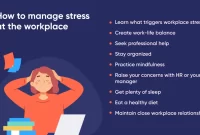Conflict Resolution at the Office
Understanding Different Conflict Resolution Styles
In any workplace, conflicts are inevitable. They can arise due to differences in opinions, work styles, or even personal values. However, how conflicts are resolved can greatly impact team dynamics and overall productivity. Understanding different conflict resolution styles can help create a more harmonious work environment.
1. Collaborative
In a collaborative conflict resolution style, individuals work together to find a mutually beneficial solution. By actively listening and engaging in open communication, team members can address the underlying issues and come up with creative solutions that satisfy all parties involved.
2. Compromising
Compromising involves finding a middle ground where each party gives up something to reach a resolution. This style may be useful when the conflicting parties have equal power or when time constraints are present. While it may not fully satisfy everyone’s needs, compromising can still lead to a resolution that is acceptable to all involved.
3. Accommodating
Accommodating involves one party putting the needs and desires of others above their own. This style can be useful when maintaining relationships and preserving harmony is more important than winning the conflict. However, it is important to ensure that accommodating does not result in one party always sacrificing their own needs.
4. Avoiding
Avoiding conflict altogether is a common response, but it is not always the most effective resolution style. While it can temporarily pacify the situation, ignoring conflicts can lead to unresolved issues that may resurface later and escalate further.
5. Competing
In a competing conflict resolution style, one party prioritizes their own goals and interests over others. This approach may be suitable when quick decision-making or decisive action is needed, but it can also strain relationships and create an unhealthy work environment.
Overall, understanding and utilizing the appropriate conflict resolution style can contribute to a collaborative and productive work environment. It is important to assess the situation and choose the style that best suits the needs of all parties involved.
Effective Communication for Conflict Resolution
Conflict Resolution at the Office can be a challenging task, but by employing effective communication strategies, conflicts can be resolved in a constructive manner. Effective communication plays a crucial role in preventing, managing, and resolving conflicts in the workplace.
Active Listening
One of the key aspects of effective communication for conflict resolution is active listening. It involves giving undivided attention to the person speaking, demonstrating empathy, and seeking clarification to ensure a clear understanding of the issue at hand. Active listening helps in fostering open dialogue and building trust among team members.
Clear and Assertive Communication
It is important to express thoughts, concerns, and opinions clearly and assertively to avoid misunderstandings and conflicts. Using “I” statements instead of “You” statements can help in expressing oneself without sounding accusatory, which can lead to defensive reactions. Clarity and assertiveness facilitate effective problem-solving discussions.
Non-Verbal Communication
Non-verbal cues such as body language, facial expressions, and tone of voice can convey messages that words alone might not. Being aware of one’s own non-verbal cues and interpreting others’ signals correctly can assist in understanding emotions, intentions, and underlying issues behind conflicts.
Respectful Feedback
Providing feedback in a respectful and constructive manner is crucial for conflict resolution. It is important to focus on the behavior or issues at hand rather than attacking the person. By offering specific feedback, acknowledging strengths, and suggesting improvements, conflicts can be addressed without causing damage to professional relationships.
Collaboration and Compromise
Conflict resolution often requires collaboration and compromise. Encouraging open dialogue and brainstorming solutions together can result in mutually agreeable outcomes. By finding common ground and seeking win-win solutions, conflicts can be resolved in a manner that preserves relationships and promotes a positive work environment.
In conclusion, effective communication is essential for conflict resolution at the office. Active listening, clear and assertive communication, non-verbal cues interpretation, respectful feedback, collaboration, and compromise are key components that contribute to resolving conflicts in a constructive and productive manner.
Mediation and Negotiation in Conflict Situations
In any office environment, conflicts can arise due to various reasons such as differences in opinions, competing interests, or misunderstandings. Conflict resolution plays a crucial role in maintaining a harmonious and productive workplace. Two effective approaches to resolving conflicts are mediation and negotiation.
Mediation
Mediation involves a neutral third party, known as a mediator, who facilitates discussions between the conflicting parties. The mediator ensures that both parties have an equal opportunity to express their concerns and perspectives. Through active listening and empathetic communication, the mediator helps the parties find common ground and explore mutually beneficial solutions.
Negotiation
Negotiation is a process where the conflicting parties engage in discussions to reach a mutually acceptable agreement. It requires open and honest communication, as well as the willingness to compromise. By identifying shared interests and exploring different options, negotiation enables the parties to find win-win solutions that address their needs.
Benefits of Mediation and Negotiation
Both mediation and negotiation offer several advantages in conflict resolution. They allow the individuals involved to maintain control over the outcome, fostering a sense of ownership and commitment to the agreed-upon solution. These approaches also promote better understanding and improved relationships among team members, enhancing collaboration and teamwork.
Conclusion
In summary, mediation and negotiation are powerful tools for conflict resolution in the office. By employing these approaches, individuals can work towards resolving conflicts constructively and fostering a positive work environment.
Conclusion
Conflict resolution is vital in the office to maintain a healthy work environment. By promoting open communication, active listening, and empathy, conflicts can be resolved effectively. Additionally, fostering a culture of collaboration and respect can prevent conflicts from escalating and ensure a productive and harmonious workplace.




